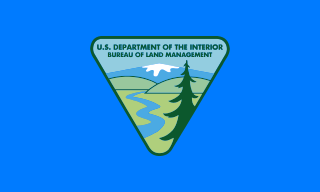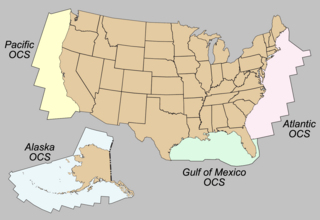This article needs to be updated.(July 2023) |
The United States House Natural Resources Subcommittee on Energy and Mineral Resources is one of the five subcommittees within the House Natural Resources Committee
This article needs to be updated.(July 2023) |
The United States House Natural Resources Subcommittee on Energy and Mineral Resources is one of the five subcommittees within the House Natural Resources Committee
| Majority | Minority |
|---|---|
|
|
| Ex officio | |
|
|
| Majority | Minority |
|---|---|
|
|
| Ex officio | |
|
|
| Majority | Minority |
|---|---|
|
|
| Ex officio | |
|
|

The Bureau of Land Management (BLM) is an agency within the United States Department of the Interior responsible for administering federal lands. Headquartered in Washington, D.C., and with oversight over 247.3 million acres (1,001,000 km2), it governs one eighth of the country's landmass.

The United States Senate Committee on Energy and Natural Resources is a standing committee of the United States Senate. It has jurisdiction over matters related to energy and mineral resources, including nuclear development; irrigation and reclamation, territorial possessions of the United States, trust lands appertaining to America's indigenous peoples, and the conservation, use, and disposition of federal lands. Its roots go back to the Committee on Interior and Insulars Affairs. In 1977, it became the Committee on Energy and Natural Resources, and most matters regarding Native Americans, Alaska Natives, and Native Hawaiians were removed from its jurisdiction and transferred to the Committee on Indian Affairs.

The Minerals Management Service (MMS) was an agency of the United States Department of the Interior that managed the nation's natural gas, oil and other mineral resources on the outer continental shelf (OCS).

The Mineral Leasing Act of 1920 30 U.S.C. § 181 et seq. is a United States federal law that authorizes and governs leasing of public lands for developing deposits of coal, petroleum, natural gas and other hydrocarbons, in addition to phosphates, sodium, sulfur, and potassium in the United States. Previous to the act, these materials were subject to mining claims under the General Mining Act of 1872.

The U.S. House Committee on Natural Resources or Natural Resources Committee is a Congressional committee of the United States House of Representatives. Originally called the Committee on Interior and Insular Affairs (1951), the name was changed to the Committee on Natural Resources in 1991. The name was shortened to the Committee on Resources in 1995 by the new chairman, Don Young. Following the Democratic takeover of the House of Representatives in 2006, the name of the committee was changed back to its title used between 1991 and 1995.
The California Department of Conservation is a department within the government of California, belonging to the California Natural Resources Agency. With a team of scientists, engineers, environmental experts, and other specialists, the Department of Conservation administers a variety of programs vital to California's public safety, environment and economy. The department's mission is to manage California's working lands. It regulates oil, natural gas and geothermal wells; studies and maps earthquakes and other geologic phenomena; maps and classifies areas containing mineral deposits; ensures reclamation of land used for mining; and administers agricultural and open-space land conservation programs. A division within the department dedicated to encouraging beverage container recycling has been moved into the newly created Department of Resources Recovery and Recycling (CalRecycle). Despite the similar name, the Department of Conservation should not be confused with the California Conservation Corps, another department within the Natural Resources Agency, which provides work experience for young adults. The Department of Conservation often collaborates with its federal equivalents, such as the U.S. Geological Survey.
The United States Senate Energy and Natural Resources Subcommittee on Energy is one of four subcommittees of the U.S. Senate Energy and Natural Resources Committee.
The United States Senate Energy and Natural Resources Subcommittee on Public Lands and Forests is one of four subcommittees of the U.S. Senate Energy and Natural Resources Committee.
The United States House Natural Resources Subcommittee on Federal Lands is one of the five subcommittees within the House Natural Resources Committee. Until the 118th Congress, it was known as the Subcommittee on National Parks, Forests and Public Lands.

The United States House Natural Resources Subcommittee on Water, Wildlife and Fisheries is one of the five subcommittees within the House Natural Resources Committee. It was previously known as the Subcommittee on Water, Oceans and Wildlife.

The Outer Continental Shelf (OCS) is a feature of the geography of the United States. The OCS is the part of the internationally recognized continental shelf of the United States which does not fall under the jurisdictions of the individual U.S. states.
The Energy Resources Conservation Board (ERCB) was an independent, quasi-judicial agency of the Government of Alberta. It regulated the safe, responsible, and efficient development of Alberta's energy resources: oil, natural gas, oil sands, coal, and pipelines. Led by eight Board members, the ERCB's team of engineers, geologists, technicians, economists, and other professionals served Albertans from thirteen locations across the province.
The Alaska Department of Natural Resources is a department within the government of Alaska in the United States of America. The department has the mission of responsibly developing Alaska's resources by making them available for maximum use and benefit consistent with the public interest.

Susan Elizabeth "Liz" Birnbaum served as Director of the Minerals Management Service in the United States from July 15, 2009, to May 27, 2010. Birnbaum was in charge of administering "programs that ensure the effective management of renewable energy [...] and traditional energy and mineral resources on the nation's Outer Continental Shelf, including the environmentally safe exploration, development, and production of oil and natural gas, as well as the collection and distribution of revenues for minerals developed on federal and American Indian lands."
The United States House Natural Resources Subcommittee on Insular and Indian Affairs is one of the five subcommittees within the House Natural Resources Committee. It was known until the 118th Congress as the Subcommittee on Indigenous Peoples of the United States.

The New Mexico Energy, Minerals and Natural Resources Department (EMNRD) is a state agency in New Mexico tasked with managing and protecting the natural and energy resources of New Mexico.
State trust lands were granted by the United States Congress to states upon entering the Union. These lands were designated to support essential public institutions which are primarily public schools. State trust land managers lease and sell these lands to generate revenue for current and future designated beneficiaries. Predominantly found in the western United States, 46 million acres of land are currently designated as trust lands and the proceeds from the lease and sale of these lands are distributed into a state's permanent fund and used for many purposes.

The Alberta Energy Regulator (AER) is a Canadian crown corporation responsible for regulating the development of energy resources in Alberta. Headquartered in Calgary, Alberta, the AER's mandate under the Responsible Energy Development Act (REDA), passed on 10 December 2012 and proclaimed on 17 June 2013, is to provide safe, efficient, orderly, and environmentally responsible development of energy resources in the province.
United States energy law is a function of the federal government, states, and local governments. At the federal level, it is regulated extensively through the United States Department of Energy. Every state, the federal government, and the District of Columbia collect some motor vehicle excise taxes. Specifically, these are excise taxes on gasoline, diesel fuel, and gasohol. While many western states rely a great deal on severance taxes on oil, gas, and mineral production for revenue, most states get a relatively small amount of their revenue from such sources.

The Lowering Gasoline Prices to Fuel an America That Works Act of 2014 is a bill that would revise existing laws and policies regarding the development of oil and gas resources on the Outer Continental Shelf. The bill is intended to increase domestic energy production and lower gas prices.